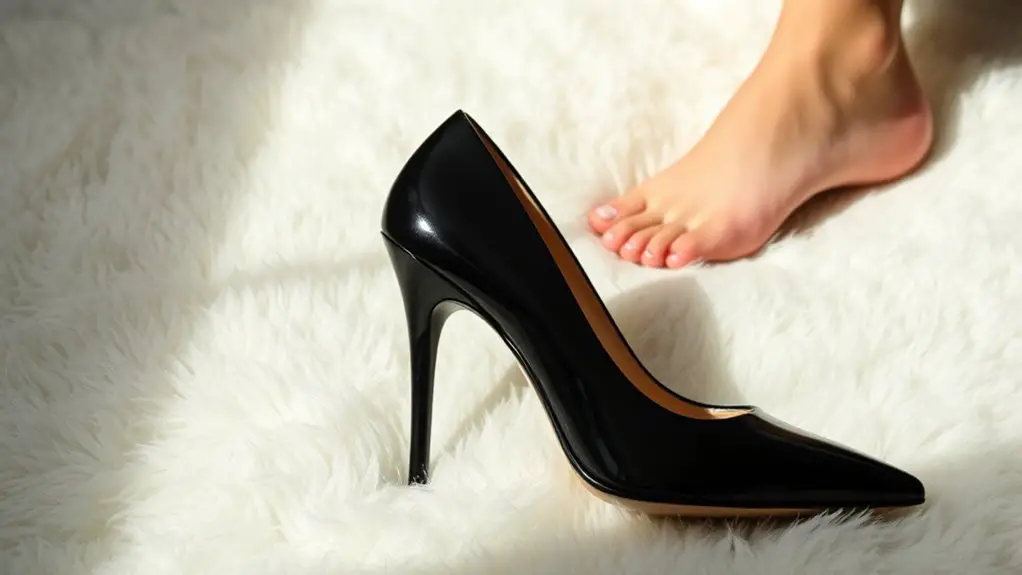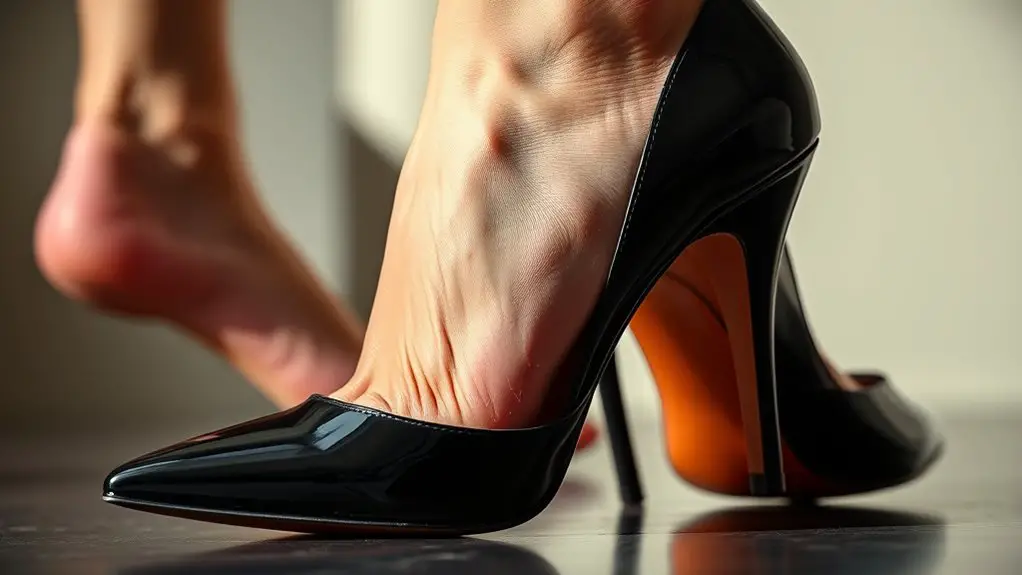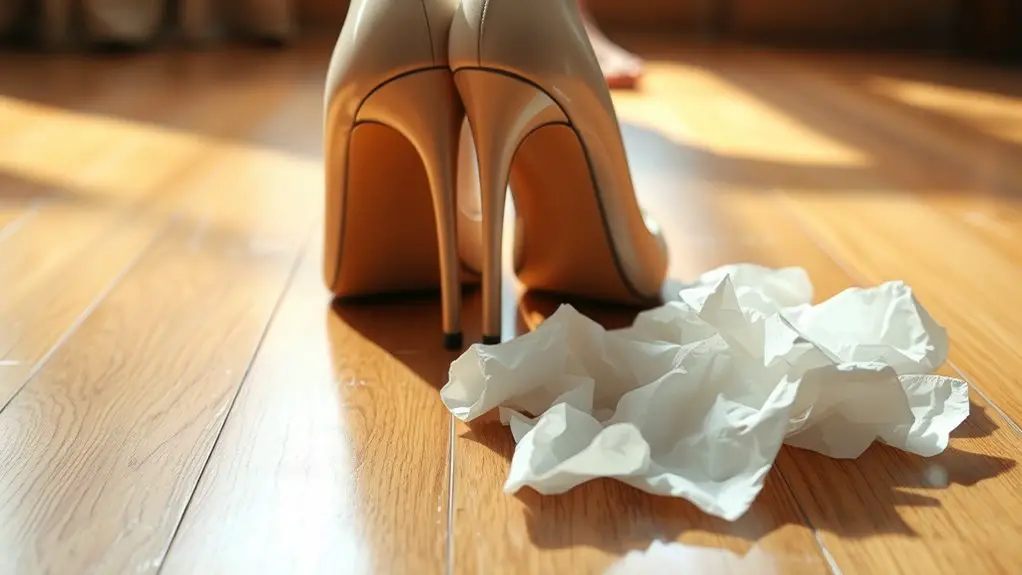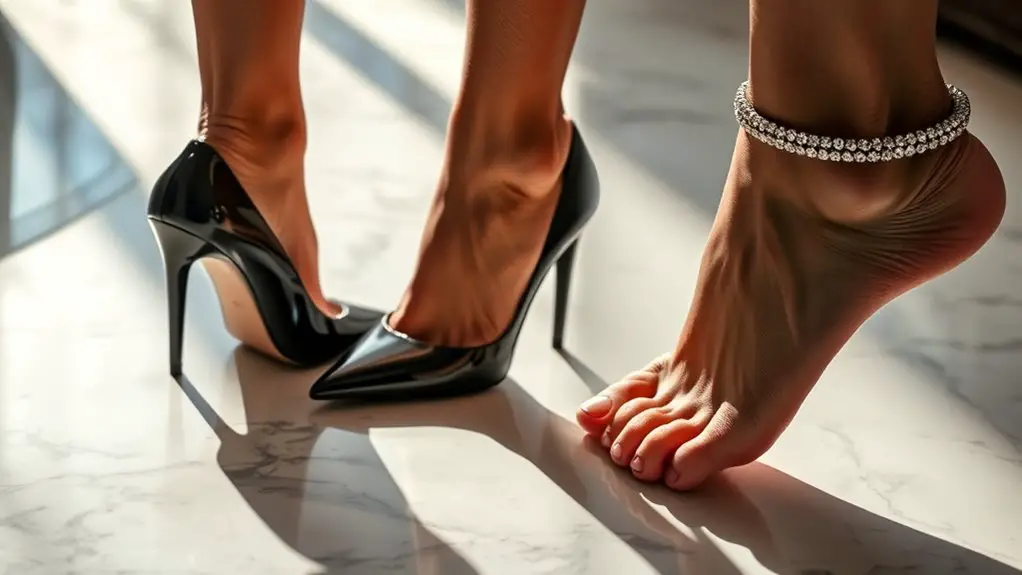Wearing high heels increases your risk of foot cramps due to altered biomechanics and pressure on your feet. Elevated heels shift body weight forward, compressing metatarsals and stressing the toes. This can lead to muscle fatigue and cramps, resulting in sharp pain and numbness. Proper arch support in your heels is essential to distribute weight evenly and reduce discomfort. By understanding these mechanics, you can better manage the effects of high heels on your feet and improve comfort.
Understanding High Heels: A Brief Overview

High heels, often seen as a symbol of fashion and elegance, greatly alter the mechanics of walking and posture. These footwear styles have evolved through various fashion trends, with designers frequently experimenting with heel heights and shapes to create visually appealing silhouettes. The materials used in high heels, such as leather, synthetic fabrics, and plastics, play a significant role in their comfort and durability.
When you wear high heels, your body shifts its center of gravity, which can lead to stress on the feet, knees, and lower back. While the aesthetic appeal can be undeniable, it’s essential to understand the potential implications for your foot health. The choice of heel materials can influence not just the shoe’s appearance but also its support and cushioning. Being aware of these factors can help you make informed decisions when selecting high heels, balancing style with foot health considerations.
The Anatomy of the Foot: How High Heels Affect Structure
When you wear high heels, the intricate structure of your foot undergoes significant changes that can lead to discomfort and potential long-term damage. High heels elevate the heel position, shifting your body weight forward and altering your natural biomechanics. This unnatural angle places excessive stress on the forefoot, compressing the metatarsal bones and leading to increased pressure on the toes.
Additionally, the arch of your foot can be adversely affected. The elevated heel position can shorten the Achilles tendon, restricting its flexibility and causing strain on the calf muscles. Over time, these changes can compromise your foot structure, leading to imbalances and instability.
Moreover, the rigid sole of high heels limits the foot’s ability to absorb shock, further exacerbating discomfort. Understanding these structural implications can help you make informed choices about footwear, ultimately preserving your foot health.
Common Foot Problems Associated With High Heels

Wearing high heels often leads to increased pressure on your toes, which can cause pain and deformities over time. Additionally, these shoes alter your gait mechanics, potentially resulting in discomfort throughout your feet and legs. Understanding these common foot problems is essential for making informed choices about footwear.
Pressure on Toes
Although many enjoy the aesthetic appeal of high heels, the pressure they exert on the toes can lead to various foot problems. Prolonged toe pressure can result in conditions such as corns, calluses, and even bunions. When your toes are cramped in a narrow shoe, it creates an environment that can lead to muscle fatigue and cramping. To mitigate these issues, consider strategies for cramp prevention, such as selecting heels with a wider toe box or opting for lower heel heights. Additionally, taking breaks to relieve toe pressure can be beneficial. Being mindful of these factors can help maintain your foot health while still enjoying the style that high heels provide.
Altered Gait Mechanics
High heels can considerably alter your gait mechanics, leading to a range of common foot problems. When you wear high heels, your body’s posture shifts, resulting in altered posture that places excess strain on your feet and lower limbs. This shift can create balance issues, as your center of gravity changes and makes it harder to maintain stability. Over time, these factors can contribute to discomfort, pain, and even injuries such as sprains or tendonitis. Additionally, the unnatural position of your foot may cause muscle imbalances, exacerbating these issues. To mitigate these risks, consider alternating between heel heights and incorporating supportive footwear into your wardrobe, ensuring your feet remain healthy and functional.
The Mechanics of Foot Cramps: What Happens When You Wear Heels
When you slip into a pair of high heels, the mechanics of your foot undergo significant changes that can lead to cramps and discomfort. Elevated heels shift your body weight forward, placing extra stress on the toes and ball of your foot. This unnatural positioning can cause muscle fatigue, increasing the likelihood of foot cramps.
| Symptoms | Effects on Foot Mechanics |
|---|---|
| Sharp pain | Tension in calf muscles |
| Tightness | Reduced blood flow |
| Numbness | Nerve compression |
| Inflammation | Joint stress |
| Fatigue | Overworked muscles |
As you navigate through your day, the strain on your foot muscles can accumulate, resulting in painful cramps. Understanding this mechanical shift is vital for recognizing the impact high heels have on your foot health.
The Role of Arch Support in High Heels

When wearing high heels, the importance of arch support can’t be overstated. Proper arch support helps distribute weight evenly, reducing strain on your feet and minimizing discomfort. Understanding the types of arch support available and their effects on foot health can greatly enhance your wearing experience.
Importance of Arch Support
Arch support plays a critical role in the comfort and stability of high heels. When you wear heels, your feet are forced into an unnatural position, leading to discomfort and cramps. Proper arch support can alleviate these issues, ensuring even weight distribution and reducing strain.
| Arch Support Benefits | Common Arch Support Materials | Impact on Comfort |
|---|---|---|
| Reduces foot fatigue | Gel inserts | Enhanced comfort |
| Improves alignment | Foam padding | Better stability |
| Prevents cramps | Leather | Long-term support |
| Promotes circulation | Arch supports | Decreased pressure |
| Enhances posture | Custom orthotics | Reduced discomfort |
Investing in quality arch support materials can greatly enhance your high-heel experience, making it both stylish and comfortable.
Types of Arch Support
Choosing the right type of arch support can greatly impact your comfort and foot health while wearing high heels. There are several arch support types to evaluate, including built-in support, removable insoles, and custom orthotics. Built-in support is often found in high-quality heels, providing moderate cushioning and stability. Removable insoles allow for flexibility, enabling you to choose the level of support that best suits your needs. Custom orthotics are tailored to your unique foot shape and can be particularly beneficial if you have specific foot issues. Additionally, the arch support materials used can affect durability and comfort; materials like gel, foam, and rigid plastics each offer distinct benefits. Selecting the appropriate combination can enhance your wearing experience considerably.
Effects on Foot Health
While many enjoy the aesthetic appeal of high heels, the role of arch support cannot be overstated in maintaining foot health. Proper arch support is essential, especially in footwear fashion where high heels dominate. Without adequate support, you risk experiencing foot cramps and other complications.
| Type of Support | Benefits | Heel Alternatives |
|---|---|---|
| Cushioned Insoles | Shock absorption | Wedges |
| Built-in Support | Enhanced stability | Block heels |
| Custom Orthotics | Personalized comfort | Low-heeled shoes |
| Arch-Supportive | Better alignment | Fashionable flats |
Choosing shoes with appropriate arch support can mitigate discomfort. Consider heel alternatives that maintain style without sacrificing foot health, ensuring you’re both fashionable and comfortable.
The Impact of Heel Height on Foot Health
When considering the effects of heel height on foot health, it’s important to recognize that elevated heels can markedly alter the body’s biomechanics. High heels shift your foot alignment, placing excessive pressure on the forefoot and leading to increased strain on the arch and heel. As heel height increases, the risk of developing foot issues, such as plantar fasciitis and metatarsalgia, escalates.
This altered foot alignment can also affect your posture, causing compensatory changes in the knees, hips, and lower back. Over time, these adjustments may result in chronic pain and discomfort, extending beyond the feet. Additionally, a lack of proper support in high-heeled shoes can lead to muscle imbalances and weakness, exacerbating the risk of foot cramps and other complications. Choosing the right heel height is vital for maintaining peak foot health and preventing long-term issues.
Choosing the Right High Heels: Tips for Comfort
How can you guarantee comfort while wearing high heels? Choosing the right pair can notably reduce foot cramps and discomfort. Here are three essential tips:
Choosing the right high heels can significantly enhance comfort and reduce foot cramps.
- Select Appropriate Heel Materials: Opt for high heels made from breathable materials like leather, which can provide better support and flexibility than synthetic options.
- Consider Heel Height and Width: Aim for a heel height that you’re comfortable with, ideally below three inches. Wider heels can also distribute weight more evenly, reducing strain on your feet.
- Incorporate Foot Exercises: Regular foot exercises can strengthen your muscles and improve flexibility. Simple stretches and toe raises can help mitigate the negative impacts of high heels.
Alternatives to High Heels: Stylish Yet Foot-Friendly Options
Although high heels are often associated with elegance and style, there are numerous alternatives that offer both fashion and comfort without compromising foot health. Comfortable flats provide a sleek look while ensuring proper foot alignment. Stylish sneakers combine functionality with contemporary design, making them suitable for various occasions. Chic loafers deliver a polished appearance, offering support and ease for long wear. For warmer weather, trendy sandals can be both fashionable and foot-friendly, designed with arch support and cushioning. Elegant wedges present a balanced option, providing height without the discomfort typical of stilettos. Finally, supportive boots offer versatility and stability, ensuring your feet remain comfortable throughout the day. By choosing these alternatives, you can maintain your style while prioritizing your foot health, reducing the risk of cramps and discomfort associated with high heels.
Foot Care Strategies for High Heel Wearers
While high heels can enhance your outfit, they often lead to discomfort if proper foot care isn’t prioritized. To mitigate the negative effects of high heel wear, consider the following strategies:
- Foot Massage: Regularly massage your feet to improve circulation and relieve tension. Focus on the arches and balls of your feet, where pressure often accumulates.
- Stretching Exercises: Incorporate stretching exercises into your routine. Calf and Achilles tendon stretches can help alleviate tightness caused by high heels, promoting flexibility and reducing cramps.
- Alternate Footwear: Whenever possible, switch to more supportive shoes during breaks or after a long day in heels. This gives your feet a chance to recover.
Frequently Asked Questions
Can High Heels Cause Long-Term Damage to My Feet?
Yes, wearing high heels can lead to long-term effects on your feet, including structural changes and chronic pain. It’s crucial to take into account these risks when choosing footwear to maintain foot health over time.
Are Certain Heel Styles Worse for Cramps Than Others?
Certain heel styles, particularly those with higher heel heights and narrower toe boxes, can exacerbate cramps. You should consider these factors when choosing heels, as they greatly impact foot comfort and overall health.
How Often Should I Take Breaks When Wearing High Heels?
You should aim for heel break frequency every 1-2 hours. Incorporating foot comfort tips, like stretching your toes and shifting weight, can greatly enhance your overall comfort while wearing high heels throughout the day.
Do High Heels Affect Other Parts of the Body?
High heels can lead to a cascade of issues; they often cause knee pain and exacerbate posture issues. Your body’s alignment is affected, creating strain in various areas, potentially leading to discomfort beyond your feet.
Can Foot Cramps Happen With Flat Shoes Too?
Yes, foot cramps can occur with flat shoes too. Insufficient arch support may lead to flat shoe discomfort, causing muscle fatigue and cramps in the feet, regardless of heel height. Proper footwear choice is essential for comfort.



